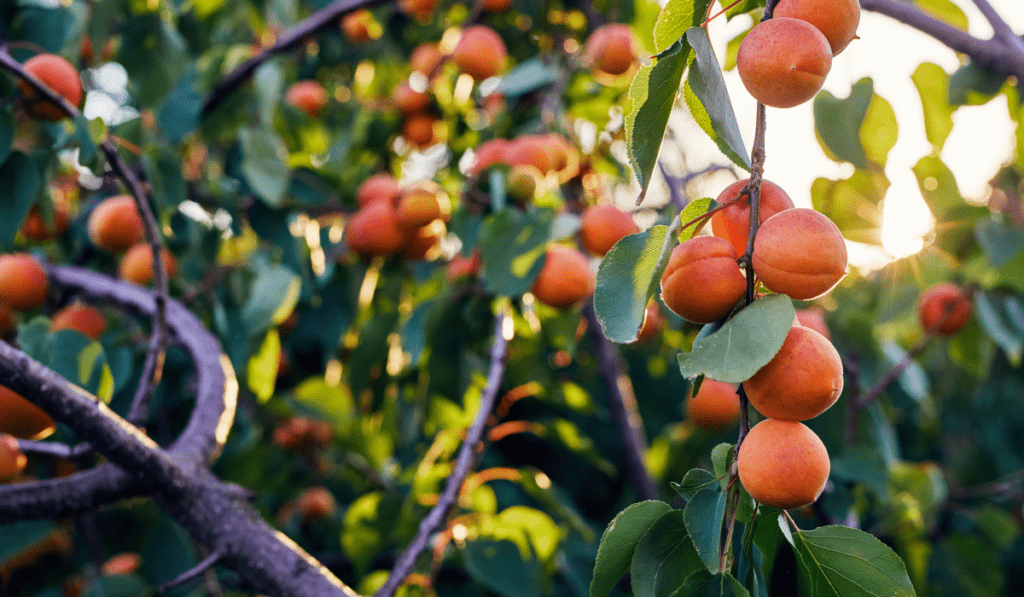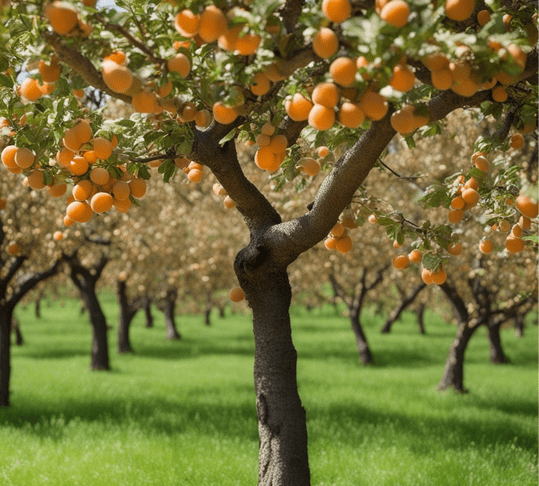When it comes to apricot trees, proper care is the key to a bountiful harvest and healthy tree growth. Whether you’re a seasoned orchardist or a backyard gardener, understanding the essential tips for year-round care is crucial. Imagine enjoying delicious homegrown apricots straight from your own tree, or even selling them at the local farmers market. With the right care, this dream can become a reality.
But where do you begin? From pruning techniques to frost protection methods, soil moisture maintenance to fertilization schedules, and pest and disease management, this blog will cover it all. We’ll even help you select the best apricot tree varieties suitable for your region. With this comprehensive guide, you’ll have all the knowledge you need to ensure the health and productivity of your apricot trees.
So, if you’re ready to take your apricot tree care to the next level, keep reading. We’ll provide you with the expert advice and actionable tips you need to succeed. Get ready to nurture your apricot trees and watch them thrive!
Caring for Apricot Trees Year Round
Taking care of apricot trees throughout the year is crucial for ensuring a bountiful harvest and maintaining the health of the trees. Year-round care involves various practices that contribute to the overall well-being and productivity of apricot trees.
One of the key reasons for providing year-round care is to promote the proper growth and development of the trees. This includes regular pruning to maintain the tree’s shape, remove dead or diseased branches, and encourage new growth. Pruning also enhances air circulation and sunlight penetration, reducing the risk of fungal diseases and improving fruit quality.
Another vital aspect of year-round care is protecting apricot trees from frost damage. Frost can harm blossoms and young fruit, leading to poor yields. Strategies such as covering the trees with frost blankets and mulching the base can help prevent frost damage, ensuring healthy fruit set and development.
Maintaining appropriate soil moisture is also crucial for apricot trees. Proper watering techniques and mulching around the base of the trees help retain moisture, preventing stress and promoting optimal growth.
In addition to these practices, fertilizing apricot trees in the fall is vital for providing the necessary nutrients for healthy growth and fruit production. Selecting the right type of fertilizer and applying it correctly ensures the trees receive the nutrition they need.
Pest and disease management is another crucial element of year-round care. Regular monitoring, early identification of pests or diseases, and implementing appropriate control measures help prevent damage and ensure tree health.
Overall, by prioritizing year-round care for apricot trees, you can enjoy an abundant harvest and nurture healthy trees that continue to thrive year after year.
Pruning Apricot Trees
Proper pruning of apricot trees plays a crucial role in their overall health and productivity. By removing dead and diseased branches and shaping the tree correctly, you can promote optimal growth and ensure a bountiful harvest. Follow these guidelines for successful pruning:
1. Remove Dead and Diseased Branches
Inspect the tree carefully and prune any dead or diseased branches. Make clean cuts close to the branch collar, the slightly swollen area where the branch joins the trunk or another branch.
2. Shaping Techniques
To maintain an open and well-structured canopy, prune branches that compete with the central leader or grow towards the tree’s interior. Encourage the development of scaffold branches that radiate outwards, creating a balanced framework.
3. Timing
The best time for pruning apricot trees is during late winter or early spring while the tree is still dormant. Avoid pruning during the growing season, as it can lead to excessive sap loss and weaken the tree.
Remember, the goal of pruning is to maintain the tree’s health, improve its structure, and maximize fruit production. By following proper pruning techniques, you can ensure the long-term vitality of your apricot tree.
Protecting Apricot Trees from Frost Damage
Apricot trees are vulnerable to frost damage, which can harm the blossoms, young fruits, and even the overall health of the tree. It is crucial to take proactive measures to protect your apricot trees from frost during colder months. Here are some effective strategies to safeguard your trees:
1. Using Frost Blankets
Covering your apricot trees with frost blankets or row covers can provide a physical barrier against cold temperatures. Secure the blankets firmly to prevent them from blowing away.
2. Mulching
Apply a layer of organic mulch around the base of the tree, extending it to the drip line. This helps insulate the soil, regulating temperature fluctuations and protecting the roots from freezing.
3. Selective Pruning
Prune your apricot trees carefully to remove any dead or damaged branches before winter sets in. This promotes proper air circulation and reduces the risk of frost damage.
4. Watering
Adequate watering in the fall helps your apricot trees stay hydrated and withstand freezing temperatures. Ensure the soil is moist but not waterlogged to maintain the tree’s health.
Remember, protecting your apricot trees from frost damage is vital to ensure a successful harvest. Implement these strategies to shield your trees and enjoy abundant and healthy apricot production.
Maintaining Soil Moisture Around Apricot Trees
Proper soil moisture is crucial for the health and productivity of apricot trees. Here’s why it matters and how you can maintain an ideal moisture level:
1. Importance of Soil Moisture
- Adequate soil moisture ensures optimal nutrient uptake and root growth.
- It helps regulate tree temperature and prevents water stress.
- Proper moisture levels promote healthy fruit development and size.
2. Watering Tips
- Water deeply and infrequently rather than shallowly and frequently.
- Apply water directly to the root zone, focusing on the drip line.
- Mulch around the base of the tree to retain moisture and reduce evaporation.
3. Monitoring and Adjusting Moisture
- Regularly check the soil moisture using a moisture meter or by digging a small hole.
- Adjust watering frequency and duration based on weather conditions.
- Avoid overwatering, as it can lead to root rot and other problems.
Remember, maintaining consistent soil moisture is key, especially during dry spells or hot weather. By ensuring adequate moisture levels, you contribute to the overall health and vitality of your apricot trees.
Fertilizing Apricot Trees in the Fall
Fall fertilization plays a crucial role in the health and productivity of apricot trees. By providing the necessary nutrients during this season, you can ensure your trees have ample resources to thrive in the coming year. Here are some important tips for fertilizing apricot trees in the fall:
1. Selecting the right fertilizer
Choose a balanced fertilizer specifically formulated for fruit trees. Look for one with a ratio of nitrogen (N), phosphorus (P), and potassium (K) that suits apricot tree needs.
2. Timing
Apply the fertilizer in late fall, after the tree has shed its leaves. This allows the nutrients to be absorbed by the roots and stored for the following growing season.
3. Application method
Spread the fertilizer evenly around the base of the tree, keeping it at least a foot away from the trunk. Avoid direct contact with the trunk as it may cause damage.
4. Dosage
Follow the manufacturer’s instructions for the amount of fertilizer to apply based on the size and age of your apricot tree.
Remember, proper fall fertilization sets the stage for healthy growth and abundant fruit production in the future.
Pest and Disease Management for Apricot Trees
When caring for apricot trees, it’s crucial to be aware of the common pests and diseases that can impact their health and productivity. By identifying and addressing these issues promptly, you can prevent further damage and ensure the longevity of your apricot trees. Here are some essential strategies for pest and disease management:
1. Regular Inspections
Conduct regular inspections of your apricot trees to detect any signs of pest infestation or disease. Look out for pests such as aphids, apricot moths, and brown rot, as well as diseases like bacterial canker and powdery mildew.
2. Pruning Practices
Prune your apricot trees carefully to remove any diseased or dead branches. This helps prevent the spread of diseases and eliminates potential hiding spots for pests.
3. Proper Sanitation
Maintain a clean and tidy orchard by removing fallen leaves, fruits, and debris. This reduces the chances of pests and diseases overwintering and reinfesting your trees.
4. Cultural Techniques
Implement cultural practices like proper pruning techniques, adequate irrigation, and responsible fertilization to promote the overall health and vigor of your apricot trees. Healthy trees are more resilient to pests and diseases.
5. Natural Predators and Biological Controls
Encourage beneficial insects and natural predators, such as ladybugs and birds, that feed on pests. Additionally, consider using biological controls like nematodes or organic insecticides as a last resort.
6. Integrated Pest Management (IPM)
Adopt an integrated approach that combines different strategies to manage pests and diseases effectively. IPM emphasizes preventive measures, monitoring, and targeted treatments to minimize the use of chemical pesticides.
Remember, early detection and proactive management are key to minimizing the impact of pest and disease issues in your apricot trees. Regularly educate yourself about the specific pests and diseases common in your region and consult with local experts for tailored advice. By adopting these management strategies, you can maintain the health and vitality of your apricot trees for a fruitful harvest.
Thinning the Crop
Thinning the crop is an important practice in apricot tree care that helps ensure the health and productivity of your trees. By selectively removing excess fruit, you allow the remaining fruit to develop properly and prevent damage to branches caused by heavy fruit loads. Here are some tips for thinning the crop effectively:
When to Thin:
Thinning should be done when the apricot tree is in the early stages of fruit development, typically in late spring or early summer. Wait until the apricots have reached marble-size before thinning.
How to Thin:
- Identify clusters of apricots that are too close together or have any deformities.
- Use a pair of pruners or your fingers to gently remove the excess apricots. Be careful not to damage the remaining apricots or the tree’s branches.
- Aim to have each apricot spaced about 6-8 inches apart from the nearest apricot.
Benefits of Thinning:
Thinning the crop has several benefits for both the tree and the quality of the apricots. Here’s why it is important:
- It helps reduce competition among apricots for sunlight, nutrients, and water.
- Thinning allows the remaining apricots to grow larger and develop better flavor.
- By removing excess apricots, you reduce the risk of branches breaking or bending under the weight of heavy fruit.
Additional Tips:
- Focus on removing smaller or misshapen apricots, leaving the healthier ones to grow.
- Thinning may need to be repeated if the tree still has a heavy fruit load after the first thinning.
Remember, thinning the crop is a proactive step in managing apricot tree health and ensuring a bountiful harvest of high-quality apricots.
Conclusion
Taking care of apricot trees is worth it, needing focus and commitment. Pay attention to watering and treating the soil right, managing illnesses in the trees and cutting branches when needed. Every step is important for your apricot trees’ health and fruitfulness. Regular checks and quick fixes can greatly improve how your apricot trees grow and the number of apricots they produce. Remember, the secret to great apricot tree care is knowing what your trees need and doing what’s right for them. Keep these tips in mind, and you’re ready to take good care of your apricot trees. You’ll love seeing their beauty and tasting the yummy apricots they grow. Enjoy your gardening!



